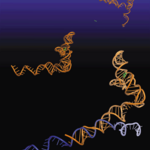A group of researchers led by Adrian Bachtold of the CIN2 laboratory in Spain has developed an ultrasensitive mass sensor, which can measure tiny amounts of mass with atomic precision, and with an unprecedented resolution to date.
The CIN2 (Research Center for Nanoscience and Nanotechnology), is a joint centre belonging to the Spanish National Council for Scientific Research (CSIC) and the Nanotechnology Catalonian Institute (ICN).
The device is based on a carbon nanotube of 1 nanometer diameter which is clamped at both ends to two electrodes. It works as an electromechanical…
Applied Physics

Scientists believe that complex diseases such as schizophrenia, major depression and cancer are not caused by one, but a multitude of dysfunctional genes. A novel computational biology method developed by a research team led by Ali Abdi, PhD, associate professor in New Jersey Institute of Technology's department of electrical and computer engineering, has found a way to uncover the critical genes responsible for disease development.
"We see our research developing a novel technology holding high promises for finding key molecules that contribute to human diseases and for…

What does it take to build a car capable of going 1,000 MPH, 30% faster than any car that has gone before? Richard Noble of Swansea University and lead of the aerodynamics team for the BLOODHOUND SSC (super sonic car) Project, intends to find out by 2011.
When it takes off, BLOODHOUND SSC will be driven by Wing Commander Andy Green, who set the current record of 763mph (1228kmh) at the controls of ThrustSSC on 15th October 1997. If the new vehicle achieves its target of 1,000 MPH (Mach 1.4) it will mark the greatest incremental increase in the history of the World Land Speed…

Engineers from the California Institute of Technology (Caltech) have created a "plug-and-play" synthetic RNA device--a sort of eminently customizable biological computer--that is capable of taking in and responding to more than one biological or environmental signal at a time.
In the future, such devices could have a multitude of potential medical applications, including being used as sensors to sniff out tumor cells or determine when to turn modified genes on or off during cancer therapy.
A synthetic RNA device is a biological device that uses engineered modular components made of RNA…

Nothing drives biologists crazier than people who think the colloquial meaning of 'junk' means junk DNA is valueless. For about 15 years, scientists have known that certain junk DNA, repetitive DNA segments previously thought to have no function, could evolve into exons, which are the building blocks for protein-coding genes in higher organisms like animals and plants.
A new University of Iowa study has found evidence that a significant number of exons created from junk DNA seem to play a role in gene regulation. The findings increase our understanding of how humans differ from other…

DONGYING, Shandong, China, October 16 /PRNewswire/ --
CNPV, a multi product solar company (ingots, wafers, solar cells & modules), with a strong presence in the Solar Photovoltaic space, is pleased to announce the appointment of Mr. B. Veerraju Chaudary as its new Chief Technology and Operating Officer (CTO & COO) with immediate effect. This appointment further advances the company's stated commitment to its future high growth and development.
Mr. B. Veerraju Chaudary has a rich experience of over 17 years in the Solar Photovoltaic industry including roles at Siemens Solar Industries…

Paleontologists have long debated the function of the strange, bony crests on the heads of the duck-billed dinosaurs known as lambeosaurs. The structures contain incredibly long, convoluted nasal passages that loop up over the tops of their skulls.
Scientists at the University of Toronto, Ohio University and Montana State University now have used CT-scanning to look inside these mysterious crests and reconstruct the brains and nasal cavities of four different lambeosaur species.
At the annual meeting of the Society for Vertebrate Paleontology in Cleveland, Ohio, the team today announced new…

A team of researchers in Canada say they have made a bold stride in the struggle to detect dark matter - and it involves listening and WIMPS. The PICASSO collaboration has documented the discovery of a significant difference between the acoustic signals induced by neutrons and alpha particles in a detector based on superheated liquids.
Since neutron induced signals are very similar to dark matter induced signals, this new discovery published in the New Journal of Physics, could lead to improved background suppression in dark matter searches with this type of detector.
So far, alpha…

MARANELLO, Italy, October 15 /PRNewswire/ -- In the news release, Ferrari Takes Microsoft's New High-Performance Computing for a Spin, issued earlier today by Microsoft over PR Newswire, we are advised by the company that the fourth paragraph, first sentence, should read "Piergiorgio Grossi, head of information systems at Ferrari Racing Team." rather than "information systems at Ferrari." as originally issued inadvertently. Complete, corrected release follows:
- Desk-side supercomputing is poised to revolutionise automotive design and engineering.
Two of the most dynamic, high-performance…

MARANELLO, Italy, October 15 /PRNewswire/ --
- Desk-side supercomputing is poised to revolutionise automotive design and engineering.
Two of the most dynamic, high-performance companies in the world joined forces today when Ferrari SpA decided to use Microsoft Corp's newest high-performance computing (HPC) technology to push the boundaries of automotive engineering, design and development.
(Logo: http://www.newscom.com/cgi-bin/prnh/20000822/MSFTLOGO)
Ferrari's sport department is one of the first companies to test Microsoft's new high-performance computing system -- Windows HPC Server 2008.…
